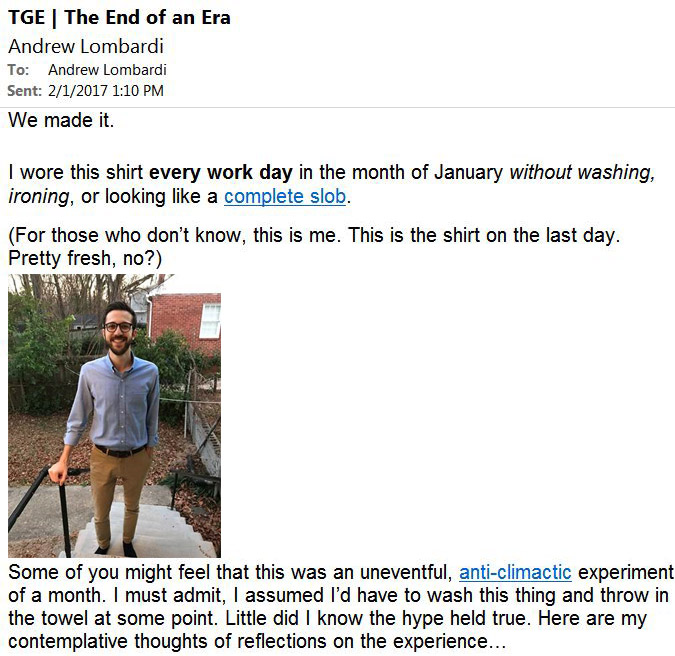Committing to the year-long minimalist challenge taught me plenty, but not having the flexibility to add an item or two to my core wardrobe was, as you can assume, quite limiting and frustrating at times. The Mindful Wardrobe was created as a more accessible year-long challenge with the following goals:
- Mindful and intentional purchasing
- Shift spending to used good (eBay, Craigslist, Grailed)
- Shift spending to smaller brands with aligned values
- Better discipline donating/selling items
I created this Google spreadsheet to track everything in my wardrobe, all physical object purchases, and sales/donations. Food, gas, services, business purchases, and digital purchases such as eBooks were excluded from the tally.
Coming off a year wearing as few items as possible, I filled the gaps in my closet with some pieces I had in storage and a couple Wool&Prince samples.
What I learned:
- It’s nearly impossible to put together a year of perfect purchases. On the same day, I bought a pair of shorts that were too short and bought a pair of pants that had a deal-breaker design detail. It took me a few wears to realize their respective flaws and by that point, I couldn’t, in good conscience, return them. I chalked these lousy purchases up to impatience and noted to, in the future, bail on shopping trips that turn into "get me out of this store asap".
- My system of highlighting areas in my wardrobe “looking to buy”, “sell or donate”, and “interested in” was the most impactful tactic to improve visibility of wardrobe needs and improve the process for thoughtful purchasing. Prior to this process, I procrastinated on purchasing decisions without giving them proper thought and would end up making a hasty purchase.
- Maintaining discipline with a wardrobe challenge can be difficult. Visual reminders like keeping certain drawers empty or a simple “do I need this?” note in the wallet or on the computer monitor can be helpful. Getting friends and the OWM community involved was helpful.
- Wearing a quality garment until it fails is quite satisfying. At this point, you can objectively measure the garment's "body of work". Also, when you're trying to minimize the stuff in your life, determining when to or when not to buy something can be an arduous task. In the case of a well-worn, failed garment, the should I buy calculation is simple: wore for x years, costs x dollars, was it worth it?
- Wardrobe creep. It’s real. Even when I don’t buy anything, my wardrobe will grow to a cluttered within a year. Maybe it’s because I own an apparel business or I have a mother who loves shopping at costco and gifting.
- Prioritize garments that work together. My Pendleton jacket fits on the small side and my Wilson&Willy jacket fits on the large side. For temps under 45 degrees, I’ll layer them. They work so well together that people ask if the Pendleton is a jacket liner. The whole is greater than the sum of its parts with these two items.
- Develop your uniform. I had two go-to outfits that I wore five out of seven days during the colder months. 1) Burgundy button-down with jeans 2) Heavy crew with khaki chinos.
What’s next:
During the Mindful Wardrobe challenge, I had moderate success with the goal of shifting more purchases to second-hand goods and small brands. Frankly, I could have done a better job here. The convenience and price of large generic brands is a powerful advantage. Going forward, I'll continue recording my purchases, sales, and donations, but I'll be taking a closer look at why I bought each item. I want to do a better job supporting brands that align with my values:
- Does the brand have great customer service and a quality guarantee?
- Is the brand growing sustainably? Self-funded or aligned capital? Non-gimmicky marketing tactics?
- Is it a place where employees are passionate about their work and care about their impact?










